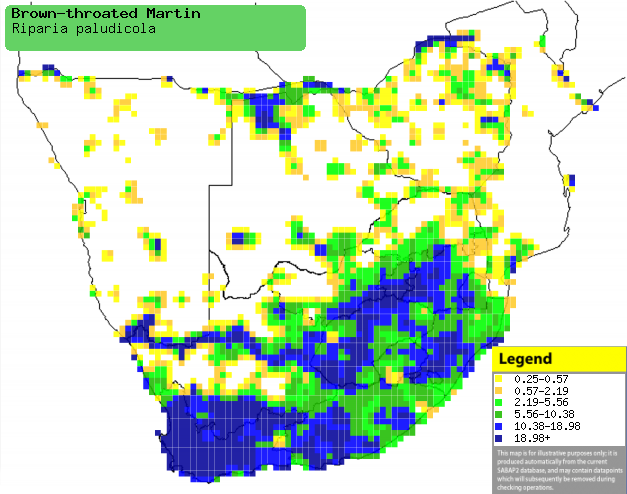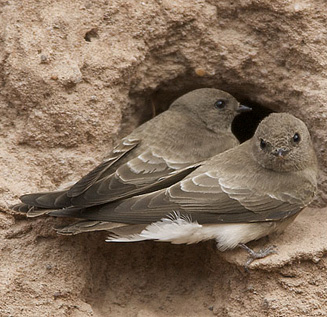|
Riparia paludicola
(Brown-throated martin)
Afrikaanse oewerswael [Afrikaans]; Sisampamema
(generic term for swallows, martins, swifts and spinetails) [Kwangali];
Lekabelane (generic term for swallows or martins), Sekatelane [South Sotho];
Nyenganyenga (generic name for swallow or martin) [Shona]; Mbawulwana, Nyenga
(generic term for swallow) [Tsonga]; Pęolwane, Phętla (generic terms for
swifts, martins and swallows) [Tswana]; Vale oeverzwaluw [Dutch]; Hirondelle
paludicole [French]; Braunkehl-uferschwalbe, Afrikanische uferschwalbe [German];
Andorinha-das-barreiras-africana [Portuguese]
Life
> Eukaryotes >
Opisthokonta
> Metazoa (animals) >
Bilateria >
Deuterostomia > Chordata >
Craniata > Vertebrata (vertebrates) > Gnathostomata (jawed
vertebrates) > Teleostomi (teleost fish) > Osteichthyes (bony fish) > Class:
Sarcopterygii (lobe-finned
fish) > Stegocephalia (terrestrial
vertebrates) > Tetrapoda
(four-legged vertebrates) > Reptiliomorpha > Amniota >
Reptilia (reptiles) >
Romeriida > Diapsida > Archosauromorpha > Archosauria >
Dinosauria
(dinosaurs) > Saurischia > Theropoda (bipedal predatory dinosaurs) >
Coelurosauria > Maniraptora > Aves
(birds) >
Order: Passeriformes > Family: Hirundinidae
Distribution and habitat
Occurs in Southern Asia, Madagascar and sub-Saharan Africa,
from western Ethiopia through Tanzania to southern Africa. Here it is locally
common across much of South Africa, Lesotho and Swaziland, but particularly
abundant in the Western Cape. It also has large populations in the Caprivi Strip
and northern and southern Botswana; much less common in Zimbabwe, Namibia and
southern Mozambique. It generally prefers rivers, open wetlands, dams, sewage
works and estuaries, also foraging over land habitats, especially fynbos, karoo
and grasslands.
|
 |
|
Distribution of Brown-throated martin in southern
Africa, based on statistical smoothing of the records from first SA Bird
Atlas Project (©
Animal Demography unit, University of
Cape Town; smoothing by Birgit Erni and Francesca Little). Colours range
from dark blue (most common) through to yellow (least common).
See here for the latest distribution
from the SABAP2. |
Movements and migrations
Resident but also nomadic, however it is
present throughout the year across its distribution range. Its local
occurrence is dependent on their being wetlands or other water
bodies available for roosting and breeding.
Food
It exclusively eats insects, doing most of its foraging in
daylight, although it may feed after sunset at emergences of aquatic insects or
termite alates. It forages in flocks over water bodies with with other swallows
and swifts, grabbing prey from the water surface. It also aerially hawks insects
over grassland or shrubland. The following food items have been recorded in its
diet:
Breeding
- Monogamous, usually colonial nester, with colonies usually comprising of
6-12 burrows.
- The nest is excavated by both sexes, consisting of an approximately
30-80 cm long tunnel ending in a chamber, where a platform built of fine
grass lined with feathers and other soft material. It is typically dug into
a vertical sandbank along a river, quarry or road cutting, occasionally
using old burrows of other birds.
 |
|
|
Brown-throated martins at nest, Tala Game Reserve, Eastern Cape. [photo Johann Grobbelaar
©] |
|
- Egg-laying season is probably year-round, usually peaking from
May-December.
- It lays 2-4 eggs, which are incubated mainly by the female for about 12
days.
- The chicks are fed by both adults, leaving the nest after about 25 days
(recorded in Kenya).
Threats
Not threatened.
References
-
Hockey PAR, Dean WRJ and Ryan PG 2005. Roberts
- Birds of southern Africa, VIIth ed. The Trustees of the John Voelcker
Bird Book Fund, Cape Town.
-
Harrison, J.A., Allan, D.G., Underhill, L.G., Herremans, M.,
Tree. A.J., Parker, V. & Brown, C.J. (eds). 1997. The atlas of southern
African birds. Vol. 2: Passerines. BirdLife South Africa, Johannesburg.
|
